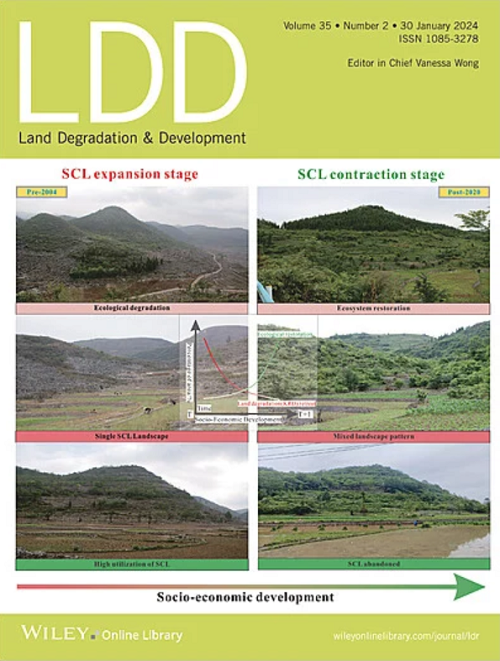Social Dynamics of Perceived Intangible Values Under Ecological Restoration Among Rural Inhabitants in Yan'an, China
IF 3.6
2区 农林科学
Q2 ENVIRONMENTAL SCIENCES
引用次数: 0
Abstract
Ecological restoration has been considered and implemented as an effective approach to reverse land degradation, particularly in vulnerable drylands. While there has been a large body of research focusing on the ecological and economic benefits of these projects, few studies have focused specifically on the intangible socio‐cultural values like cultural heritage, identity, and social cohesion in these areas. The difficulty in quantifying these values lies in their subjective perception among individuals and keep changing dynamic social contexts. Therefore, it remains unclear about how local inhabitants perceive the intangible cultural and social benefits provided by dryland ecosystems and how this perception impact community well‐being. This study employs the Cultural Ecosystem Services (CES) framework to evaluate how rural communities perceive the intangible benefits under ecological restoration. We re‐classify the commonly used ten types of CES into four main categories, auto‐responsive/intrinsic, behaviors, meanings and personal. We conducted 466 semi‐structured household interviews across 17 representative villages in Yan'an, China's Loess Plateau region. Through latent class analysis, we identified three distinct perception patterns of CES. Results revealed universal recognition of all CES types, with education and income significantly influencing their perceptions. Certain landscapes like grasslands and villages strongly shaped “sense of place” and social connections, while wetlands and waterfalls had minimal impact. Social engagement, particularly employment, enhanced CES recognition, whereas religious activities showed limited influence. This exploratory study examines the social dynamics of perceived intangible values in dryland ecosystem restoration. Our innovation lies in applying the CES framework to assess these values in dryland areas, using latent class analysis to identify three perception categories linked to demographics, landscapes, and activities. This approach offers targeted suggestions for enhancing CES, supporting ecological restoration policies that value both nature and culture. While our study establishes a foundation, further long‐term research is needed to fully understand the relationship between CES perceptions and ecological restoration outcomes.生态修复下延安农村居民无形价值感知的社会动态
生态恢复已被认为是扭转土地退化的有效方法,特别是在脆弱的旱地。虽然有大量的研究关注这些项目的生态和经济效益,但很少有研究专门关注这些地区的文化遗产、身份和社会凝聚力等非物质社会文化价值。量化这些价值的困难在于个体的主观感知和不断变化的动态社会环境。因此,当地居民如何感知旱地生态系统提供的非物质文化和社会效益,以及这种感知如何影响社区福祉,目前尚不清楚。本研究采用文化生态系统服务(CES)框架来评估农村社区如何感知生态修复下的无形利益。我们将常用的十种消费电子产品重新划分为四大类:自动反应/内在、行为、意义和个人。我们在中国黄土高原地区延安17个具有代表性的村庄进行了466次半结构化家庭访谈。通过潜在类分析,我们确定了三种不同的感知模式。结果显示,人们普遍认可所有类型的消费电子产品,教育和收入显著影响他们的看法。某些景观,如草原和村庄,强烈地塑造了“地方感”和社会联系,而湿地和瀑布的影响最小。社会参与,特别是就业,提高了对社会消费意识的认识,而宗教活动的影响有限。本探索性研究考察了旱地生态系统恢复中感知的无形价值的社会动态。我们的创新之处在于应用CES框架来评估旱地地区的这些价值,使用潜在类别分析来确定与人口统计、景观和活动相关的三种感知类别。该方法为加强CES提供了有针对性的建议,支持重视自然和文化的生态恢复政策。虽然我们的研究奠定了基础,但还需要进一步的长期研究来充分了解消费环境感知与生态恢复结果之间的关系。
本文章由计算机程序翻译,如有差异,请以英文原文为准。
求助全文
约1分钟内获得全文
求助全文
来源期刊

Land Degradation & Development
农林科学-环境科学
CiteScore
7.70
自引率
8.50%
发文量
379
审稿时长
5.5 months
期刊介绍:
Land Degradation & Development is an international journal which seeks to promote rational study of the recognition, monitoring, control and rehabilitation of degradation in terrestrial environments. The journal focuses on:
- what land degradation is;
- what causes land degradation;
- the impacts of land degradation
- the scale of land degradation;
- the history, current status or future trends of land degradation;
- avoidance, mitigation and control of land degradation;
- remedial actions to rehabilitate or restore degraded land;
- sustainable land management.
 求助内容:
求助内容: 应助结果提醒方式:
应助结果提醒方式:


